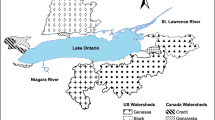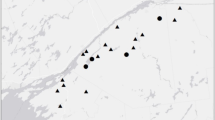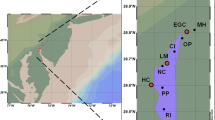Abstract
We studied methylmercury (MeHg) and totalmercury (HgT) in impounded and natural surface waters innorthwestern Minnesota, in settings ranging from agriculturalto undeveloped. In a recently constructed (1995) permanent-pool impoundment, MeHg levels typically increased from inflowto outflow during 1997; this trend broke down from late 1998 toearly 1999. MeHg levels in the outflow reached seasonal maximain mid-summer (maximum of 1.0 ng L-1 in July 1997) andlate-winter (maximum of 6.6 ng L-1 in February 1999), andare comparable to high levels observed in new hydroelectricreservoirs in Canada. Spring and autumn MeHg levels weretypically about 0.1–0.2 ng L-1. Overall, MeHg levels inboth the inflow (a ditch that drains peatlands) and outflowwere significantly higher than in three nearby referencenatural lakes. Eleven older permanent-pool impoundments andsix natural lakes in northwestern Minnesota were sampled fivetimes. The impoundments typically had higher MeHg levels(0.071–8.36 ng L-1) than natural lakes. Five of six lakesMeHg levels typical of uncontaminated lakes (0.014–1.04 ngL-1) with highest levels in late winter, whereas ahypereutrophic lake had high levels (0.37–3.67 ng L-1)with highest levels in mid-summer. Seven temporary-poolimpoundments were sampled during summer high-flow events. Temporary-pool impoundments that retained water for about 10–15days after innundation yielded pronounced increases in MeHgfrom inflow to outflow, in one case reaching 4.6 ng L-1,which was about 2 ng L-1 greater than the mean inflowconcentration during the runoff event.
Similar content being viewed by others
References
Abernathy, A. R. and Cumbie, P. M.: 1977, 'Mercury accmulation by largemouth bass (Micropterus salmoides) in recently impounded reservoirs', Bull. Environ. Contam. Toxicol. 17, 595–602.
Adolfs, K.: 1991, 'Good Lake Impoundment Project', Red Lake Watershed District, Thief River Falls, Minn., variously paged.
Bodaly, R. A., Hecky, R. E. and Fudge, R. J. P.: 1984, 'Increases in fish mercury levels in lakes flooded by the Churchill River Diversion, northern Manitoba', Can. J. Fish. Aquat. Sci. 41, 682–691.
Bodaly, R. A., St. Louis, V. L., Paterson, M. J., Fudge, R. J. P., Hall, B. D., Rosenberg, D. M. and Rudd, J. W. M.: 1997, 'Bioaccumulation of mercury in the aquatic food chain in newly flooded areas', in: A. Sigel and H. Sigel (eds), Metal Ions in Biological Systems, Vol. 34, Marcel Decker, Inc., New York, pp. 259–287.
Brigham, M. E., Olson, M. L. and DeWild, J. F.: 2000, 'Mercury, methylmercury, and other water-quality data from flood-control impoundments and natural waters of the Red River of the North Basin, Minnesota, 1997-99', U.S. Geological Survey Open-File Report 99-273A, 34 pp.
Brouard, D., Doyon, J.-F. and Schetagne, R.: 1994, 'Amplification of mercury concentrations in Lake Whitefish (Coregonus clupeaformis) downstream from the La Grande 2 Reservoir, James Bay, Quebec', in: C. J. Watras and J. W. Huckabee (eds), Mercury Pollution — Integration and Synthesis, Lewis Publishers, Boca Raton, Florida, pp. 369–379.
Compeau, G. C. and Bartha, R.: 1985, 'Sulfate-reducing bacteria—principal methylators of mercury in anoxic estuarine sediment', Appl. Environ. Microbiol. 50, 498–502.
Fitzgerald, W. F., Engstrom, D. R., Mason, R. P. and Nater, E. A.: 1998, 'The case for atmospheric mercury contamination in remote areas', Environ. Sci. Technol. 32, 1–7.
French, K. J., Anderson, M. R., Scruton, D. A. and Ledrew, L. J.: 1998, 'Fish mercury levels in relation to characteristics of hydroelectric reservoirs in Newfoundland, Canada', Biogeochemistry 40, 217–233.
Gilmour, C. C., Henry, E. A. and Mitchell, R.: 1992, 'Sulfate stimulation of mercury methylation in freshwater sediments', Environ. Sci. Technol. 26, 2281–2287.
Hecky, R. E., Ramsey, D. J., Bodaly, R. A. and Strange, N. E.: 1991, 'Increased methylmercury contamination in fish in newly formed freshwater reservoirs', Advances in Mercury Toxicology, 33–52.
Heyes, A., Moore, T. R. and Rudd, J. W. M.: 1998, 'Mercury and methylmercury in decomposing vegetation of a pristine and impounded wetland', J. Environ. Qual. 27, 591–599.
Jin, L., Hui, Y. and Xu, X.: 1999, 'Predictive model for mercury accumulation in carp (Cyprinus carpio) of reservoirs in China', Water, Air, Soil Pollut. 115, 363–370.
Kelly, C. A., Rudd, J. W. M., Bodaly, R. A., Roulet, N. P., St. Louis, V. L., Heyes, A., Moore, T. R., Schiff, S., Aravena, R., Scott, K. J., Dyck, B., Harris, R., Warner, B. and Edwards, G.: 1997, 'Increases in fluxes of greenhouse gases and methyl mercury following flooding of an experimental reservoir', Environ. Sci. Technol. 31, 1334–1344.
Meyer, M. W., Evers, D. C., Hartigan, J. J. and Rasmussen, P. S.: 1998, 'Patterns of common loon (Gavia immer) mercury exposure, reproduction, and survival in Wisconsin, USA', Environ. Toxicol. Chem. 17, 184–190.
Minnesota Department of Health: 1996, 'Minnesota fish consumption advisory', Minnesota Department of Health, Health Risk Assessment Unit, Division of Environmental Health, 84 pp.
Nater, E. A. and Grigal, D. F.: 1992, 'Regional trends In mercury distribution across the Great Lakes States, North Central USA', Nature 358, 139–141.
Olson, M. L., Cleckner, L. B., Hurley, J. P., Krabbenhoft, D. P. and Heelan, T. W.: 1997, 'Resolution of matrix effects on analysis of total and methyl mercury in aqueous samples from the Florida Everglades', Fresenius J. Analyt. Chem. 358, 392–396.
Olson, M. L. and DeWild, J. F.: 1999, 'Techniques for the collection and species-specific analysis of low levels of mercury in water, sediment, and biota', in: D. W. Morganwalp and H. T. Buxton (eds.), U.S. Geological Survey Toxic Substances Hydrology Program — Proceedings of the technical meeting, Charleston, South Carolina, March 8-12, 1999 — volume 2 of 3-Contamination of hydrologic systems and related ecosystems, U.S. Geological Survey Water-Resources Investigations Report 99-4018B, pp. 191–200.
St. Louis, V. L., Rudd, J. W. M., Kelly, C. A., Beaty, K. G., Bloom, N. S. and Flett, R. J.: 1994, 'Importance of wetlands as sources of methyl mercury to boreal forest ecosystems', Can. J. Fish. Aquat. Sci. 51, 1065–1076.
Stoner, J. D., Lorenz, D. L., Wiche, G. J. and Goldstein, R. M.: 1993, 'Red River of the North Basin, Minnesota, North Dakota, and South Dakota', Water Resources Bulletin 29, 575–615.
Swain, E. B., Engstrom, D. R., Brigham, M. E., Henning, T. A. and Brezonik, P. L.: 1992, 'Increasing rates of atmospheric mercury deposition in midcontinental North America', Science 257, 784–787.
U.S. Army Corps of Engineers and Minnesota Department of Natural Resources: 1996, 'Environmental impact study of flood control impoundments in northwestern Minnesota', U.S. Army Corps of Engineers and Minnesota Department of Natural Resources, variously paged.
U.S. Environmental Protection Agency: 1996, 'Method 1669 — Sampling ambient water for trace metals at EPA water quality criteria levels', U.S. Environmental Protection Agency, EPA 821/R-96-011, Washington, D.C., 35 pp.
U.S. Environmental Protection Agency: 1997, 'Mercury study report to Congress volume V-health effects of mercury and mercury compounds', U.S. Environmental Protection Agency, EPA-452/R-97-007, 349 pp.
U.S. Environmental Protection Agency: 1998, 'Method 1630 — methyl mercury in water by distillation, aqueous ethylation, purge and trap, and cold vapor atomic fluorescence spectrometry', U.S. Environmental Protection Agency, Draft Method 1630, August 1998, Washington, D.C., 46 pp.
U.S. Environmental Protection Agency: 1999, 'Method 1631, Revision B — Mercury in water by oxidation, purge and trap, and cold vapor atomic fluorescence spectrometry', U.S. Environmental Protection Agency, EPA-821-R-99-005, Washington, D.C., 33 pp.
Wiener, J. G. and Spry, D. J.: 1996, 'Toxicological significance of mercury in freshwater fish', in: W. N. Beyer, G. H. Heinz and A. W. Redmon (eds.), Environmental Contaminants in Wildlife: Interpreting Tissue Concentrations, Lewis Publishers, Boca Raton, FL, pp. 297–339.
Wolfe, M. F., Schwarzbach, S. and Sulaiman, R. A.: 1998, 'Effects of mercury on wildlife: a comprehensive review', Environ. Toxicol. Chem. 17, 146–160.
Author information
Authors and Affiliations
Corresponding author
Rights and permissions
About this article
Cite this article
Brigham, M.E., Krabbenhoft, D.P., Olson, M.L. et al. Methylmercury in Flood-Control Impoundments and Natural Waters of Northwestern Minnesota, 1997–99. Water, Air, & Soil Pollution 138, 61–78 (2002). https://doi.org/10.1023/A:1015573621474
Issue Date:
DOI: https://doi.org/10.1023/A:1015573621474




